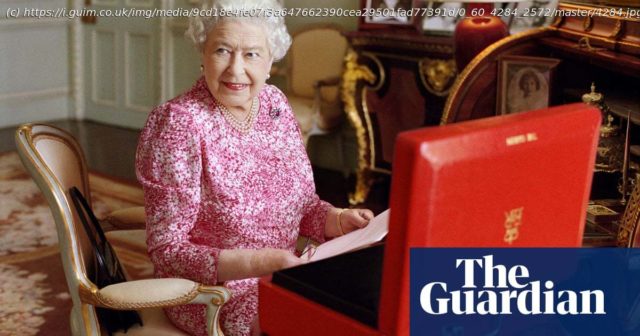Array
Elizabeth II’s job as queen was imposed on her by an ancient constitution that required no qualification other than that she exist.
Having been appointed, and whatever her private thoughts, she performed her role over an extraordinarily long reign in near-faultless manner, leaving scant ammunition for personal attack from the fiercest opponents of hereditary principle.
As Britain hurtled through times of astonishing societal change, she faced many challenges in keeping the monarchy apace – and yet she succeeded in remaining a force for national cohesion. A constant: familiar in brightly coloured coat, brimmed hat and handbag, she glad-handed her way through “walkabouts”, garden parties, ship launches, plaque unveilings, tree plantings, building inaugurations – the bread and butter of her engagements diary – with an inscrutable smile in place.
Becoming queen at such a young age meant the world knew little of her personality and views before her accession, and she continued to reveal little thereafter. She never uttered a controversial opinion in public, though supporters and critics would differ over whether this was simply because she held none, or whether she was a master of the art of political neutrality.
When caught in a maelstrom, it was most likely she had been thrust there by a lack of precedent in the protocol on which her life was solidly predicated, or wrong-footed by politicians or the antics of the younger royals.
She once said: “Of course, in this existence, the job and the life go together – you can’t really divide it up.” To some extent the person and position were one and the same. Yet not entirely. She kept much back. Only those closest knew Elizabeth the wife, mother, grandmother and excellent mimic. Though the masses caught occasional glimpses of the private woman, she remained largely an enigma, and will do so until the diaries, which in royal tradition she wrote daily, are made public.
Princess Elizabeth Alexandra Mary was born third in line to the throne on 21 April 1926, at 17 Bruton Street, Mayfair, her maternal grandparents’ London home, 12 days before the general strike. Three months previously, John Logie Baird had given his first public demonstration of television, which would, as high-speed travel and the internet did later, transform the world during her lifetime.
When her uncle David, then Edward VIII, abdicated over his determination to marry the American divorcee Wallis Simpson, destiny cast Elizabeth as heir presumptive at the age of 10. For the obedient, sensible princess, who neatly lined up her toy ponies outside the nursery door each night, and who was being home-schooled for an aristocratic life as a minor royal, it was a traumatic turn of events. She could, her grandmother Lady Strathmore said later, be seen at night “ardently praying for a brother”. None came.
Her stammering, introvert father, George VI, died prematurely in 1952, when she was 25, a young wife and mother of two, who had hoped for many more years between herself and the crown.
In the Elizabeth R documentary for the BBC, marking the 40th anniversary of her accession, she explained: “In a way, I didn’t have an apprenticeship. My father died much too young. It was all a very sudden kind of taking on and making the best job you can. It’s a question of maturing into something one has got used to doing and accepting that here you are and that is your fate, because I think continuity is very important. It’s a job for life.”
It was a succinct summary of her matter-of-fact attitude towards her lot.
The coronation in 1953 brought tens of thousands of people to the Mall. In unseasonably cold June drizzle and amid a blizzard of commemorative kitsch, the dazzling young queen was crowned with her handsome consort, Prince Philip, at her side. The public adoration and global fascination she attracted in those early years was of a level unmatched until Lady Diana Spencer joined the family firm 30 years later. A third of her subjects believed her to have been chosen by God. Deference was the order of the day.
Philip was at her side for 73 years. She was bereft at the loss of her lifelong companion after he died in his sleep at the age of 99 in April 2021. His death, during the Covid pandemic, led to her sitting alone and bereaved in St George’s Chapel, Windsor Castle, during the poignant funeral, hugely scaled down because of coronavirus restrictions. The two had spent the last months of his life together in lockdown, shielding at Windsor because of their vulnerability to the virus due to their advanced years.
Though duty and diligence were her own watchwords, there were occasions when Elizabeth found herself on the back foot despite her best endeavours. Her nadir, perhaps, was 1992, described by the Queen herself as her “annus horribilis”, a year when a scandal-weary public questioned whether misbehaving royals were deserving of their tax-free status and taxpayer-funded lifestyle. Dissent was fuelled by newspapers that had long ditched deference in favour of circulation-boosting headlines. The frenzy over the state of the marriages of the Prince of Wales and Duke of York was in full spate.
The Yorks separated, Princess Anne divorced, Andrew Morton published his disquieting Diana: Her True Story, and embarrassing taped calls – one involving Diana, the other between Charles and his then lover, Camilla Parker Bowles – found their way into the tabloids.
When part of Windsor Castle then burned down and a disconsolate Queen stood watching in a drab raincoat, a rare tear glistening, there was an outpouring of sympathy. It was swiftly surpassed by outrage when the government suggested taxpayers pick up the repair bill.
The speech she delivered at Guildhall at the end of that year was remarkable and unprecedented in tone. Buffeted and bewildered, she made a candid, open appeal for understanding. “No institution – City, monarchy, whatever – should expect to be free from the scrutiny of those who give it their loyalty, not to mention those who don’t.” Most people tried to do the best job they could, she added in a thinly veiled personal plea. “I dare say that history will take a slightly more moderate view than that of some contemporary commentators.” She was, undoubtedly, wounded.
Within the month, it was announced Charles and Diana would separate, the Queen and Charles would pay tax on their private incomes, the civil list would be axed for the extended royals, and she would open Buckingham Palace to the public to pay for the Windsor repairs. It was a dramatic low point that highlighted the irreversible shift in the relationship between subjects and sovereign. So long as royal lives were irreproachable, some argument for privacy could be made. Once this ceased to be the case, the rules changed. Unwelcome publicity was something she would have to endure.
As best befits a constitutional monarchy, Elizabeth II appeared largely to be a passive queen, proving to be a more than competent mouthpiece for her governments in delivering the often stilted words of politicians or starched-shirt courtier advisers.
As a mother, too, she displayed some passive tendencies, tending to leave her children to their own business. She was said to immerse herself in her red boxes, containing official government correspondence, rather than face family rows and other emotional dramas.
Nonetheless, her family were the cause of some of the more turbulent times of her reign. When, in 2020, the Duke and Duchess of Sussex stepped back as senior working royals and decamped to the US to seek freedom and the ability to earn their own money, it was the beginning of a difficult chapter for the monarchy.
Harry and Meghan gave a bombshell interview with Oprah Winfrey in March 2021, while Philip was in hospital, in which they accused an unnamed member of the royal family of racism towards their son Archie before he was born, and the institution of failing to help the suicidal duchess.






